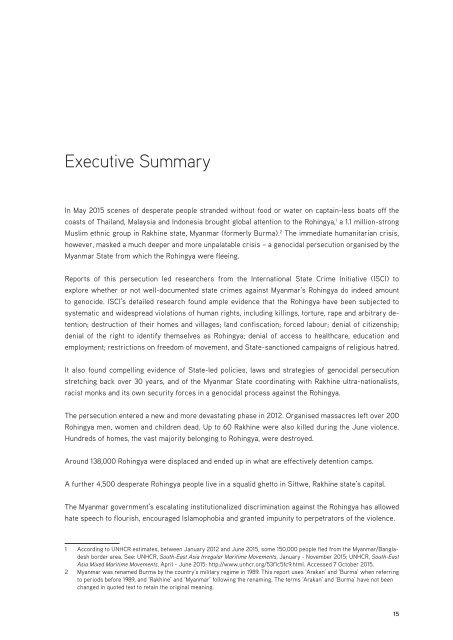You also want an ePaper? Increase the reach of your titles
YUMPU automatically turns print PDFs into web optimized ePapers that Google loves.
Executive Summary<br />
In May 2015 scenes of desperate people stranded without food or water on captain-less boats off the<br />
coasts of Thailand, Malaysia and Indonesia brought global attention to the Rohingya, 1 a 1.1 million-strong<br />
Muslim ethnic group in Rakhine state, Myanmar (formerly Burma). 2 The immediate humanitarian crisis,<br />
however, masked a much deeper and more unpalatable crisis – a genocidal persecution organised by the<br />
Myanmar State from which the Rohingya were fleeing.<br />
Reports of this persecution led researchers from the International State Crime Initiative (ISCI) to<br />
explore whether or not well-documented state crimes against Myanmar’s Rohingya do indeed amount<br />
to genocide. ISCI’s detailed research found ample evidence that the Rohingya have been subjected to<br />
systematic and widespread violations of human rights, including killings, torture, rape and arbitrary detention;<br />
destruction of their homes and villages; land confiscation; forced labour; denial of citizenship;<br />
denial of the right to identify themselves as Rohingya; denial of access to healthcare, education and<br />
employment; restrictions on freedom of movement, and State-sanctioned campaigns of religious hatred.<br />
It also found compelling evidence of State-led policies, laws and strategies of genocidal persecution<br />
stretching back over 30 years, and of the Myanmar State coordinating with Rakhine ultra-nationalists,<br />
racist monks and its own security forces in a genocidal process against the Rohingya.<br />
The persecution entered a new and more devastating phase in 2012. Organised massacres left over 200<br />
Rohingya men, women and children dead. Up to 60 Rakhine were also killed during the June violence.<br />
Hundreds of homes, the vast majority belonging to Rohingya, were destroyed.<br />
Around 138,000 Rohingya were displaced and ended up in what are effectively detention camps.<br />
A further 4,500 desperate Rohingya people live in a squalid ghetto in Sittwe, Rakhine state’s capital.<br />
The Myanmar government’s escalating institutionalized discrimination against the Rohingya has allowed<br />
hate speech to flourish, encouraged Islamophobia and granted impunity to perpetrators of the violence.<br />
1 According to UNHCR estimates, between January 2012 and June 2015, some 150,000 people fled from the Myanmar/Bangladesh<br />
border area. See: UNHCR, South-East Asia Irregular Maritime Movements, January - November 2015; UNHCR, South-East<br />
Asia Mixed Maritime Movements, April - June 2015: http://www.unhcr.org/53f1c5fc9.html. Accessed 7 October 2015.<br />
2 Myanmar was renamed Burma by the country’s military regime in 1989. This report uses ‘Arakan’ and ‘Burma’ when referring<br />
to periods before 1989, and ‘Rakhine’ and ‘Myanmar’ following the renaming. The terms ‘Arakan’ and ‘Burma’ have not been<br />
changed in quoted text to retain the original meaning.<br />
15



